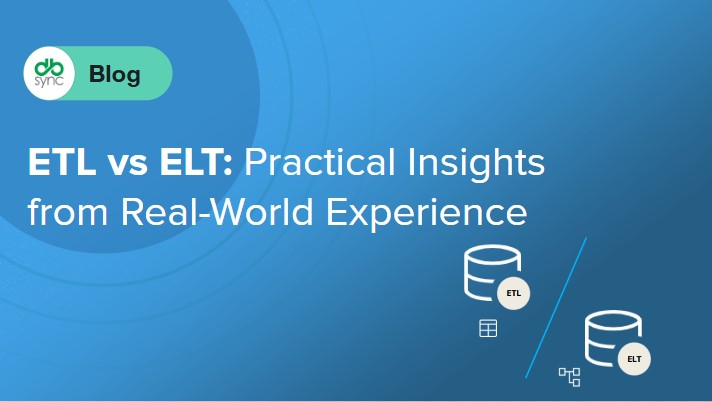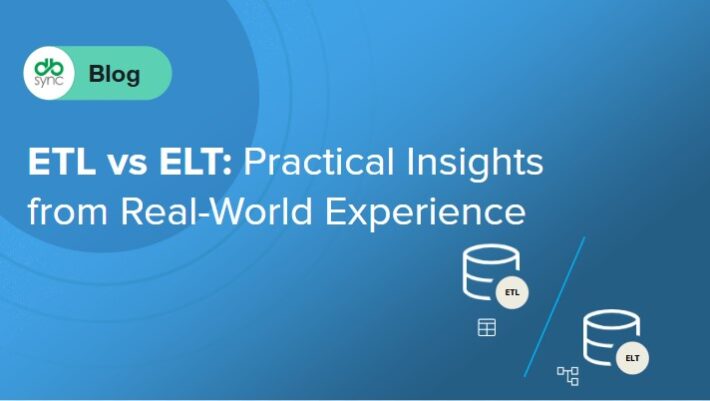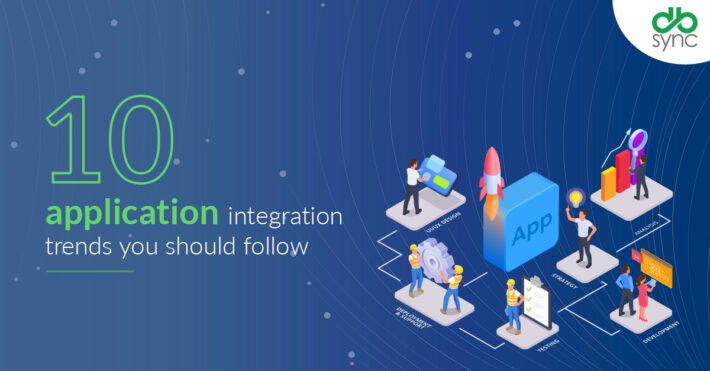ETL vs ELT: Practical Insights from Real-World Experience

Today, when you talk about ETL vs ELT, the first question to ask is—Why do we even need it?
Every business deals with massive amounts of data daily—financial transactions, customer interactions, operational records—you name it. The real challenge isn’t just collecting this data; it’s about processing it efficiently and making it useful for analysis. That’s where ETL (Extract, Transform, Load) and ELT (Extract, Load, Transform) come into play.
Both approaches are widely used for data integration, but they differ in execution. Over the years, while working closely with clients at DBSync, we’ve seen firsthand how choosing the right approach can impact business operations, data efficiency, and decision-making. Some businesses require structured and processed data before loading, while others benefit from storing raw data and transforming it later.
Through this blog, we’ll share practical insights from our experience, highlighting key differences, use cases, and technical aspects that will help you make informed decisions about your data integration strategy.
What is ETL?
ETL, which stands for Extract, Transform, and Load, is a traditional method of data integration. In this approach, data is first extracted from the source system, transformed (cleansed and formatted), and then loaded into the target data warehouse or system. ETL focuses on transforming data to ensure consistency, quality, and structure before it is made available for reporting and analysis.
Real-World Application of ETL
One of the projects I worked on involved a client in the retail industry, where we needed to consolidate data from multiple stores and customer behavior data from CRM systems. This required a lot of data cleansing, where data from various sources had to be normalized into a standard format before it could be loaded into the system.
In this case, the ETL method proved to be highly effective. We were able to extract transactional data from the retail systems, clean and transform it to match the reporting requirements and load it into the data warehouse. As a result, the client was able to analyze customer patterns and make data-driven decisions to optimize inventory and marketing strategies.
When is ETL the Right Choice?
ETL tends to be the best choice when:
- Data sources are structured, and there’s a need for rigorous transformations, such as cleansing, validation, or data enrichment.
- Data governance is crucial, such as in industries like finance or healthcare, where data integrity and accuracy are paramount.
- The integration process involves batch processing, and data volume is moderate to high, but real-time analysis isn’t a critical requirement.
In my experience, ETL works particularly well in environments where the priority is on ensuring data quality and integrity before it’s loaded into a system. It’s well-suited for industries that require strict regulatory compliance or where the data transformation needs are complex and need to be executed before loading.
What is ELT?
ELT, which stands for Extract, Load, and Transform, is a more modern approach to data integration, particularly for big data applications. In ELT, data is first extracted from the source system and loaded directly into the target system (such as a cloud-based data warehouse). Transformation happens after the data is loaded into the target system, typically using the computational power of cloud platforms or big data processing tools like Apache Spark or SQL.
Real-World Application of ELT
For a healthcare client I supported, ELT proved to be an ideal approach. The project involved integrating patient data, lab results, and appointment histories from multiple sources into a cloud data warehouse. Given the sheer volume of data and the need for real-time processing, the ELT method allowed us to load the data quickly and perform transformations using the processing power of the cloud-based data warehouse.
This approach helped the client significantly reduce processing times, allowing for faster insights into patient care and enabling more responsive decision-making by healthcare providers. Moreover, it helped optimize operational workflows, which was critical for improving patient outcomes.
When is ELT the Right Choice?
ELT is typically the best choice when:
● Large volumes of data need to be processed, and the cloud infrastructure provides the scalability required for processing that data efficiently.
● Real-time analytics or near-real-time data transformation is necessary, allowing for data to be ingested quickly and processed dynamically within the target system. ● The transformation logic is flexible and can be applied after the data is loaded, leveraging the power of modern cloud services for on-demand transformations.
In my experience, ELT shines in big data environments where processing speed and scalability are key, such as in industries like healthcare, e-commerce, and IoT.
Key Differences Between ETL and ELT: A Practical Comparison
| Feature | ETL | ELT |
| Data Volume | Best for small to medium volumes of structured data | Designed for large-scale, high-volume data |
| Data Transformation | Occurs before loading into the target system | Happens after loading into the target system |
| Processing Power | Relies on a dedicated ETL server for processing | Leverages the target system’s computational power (e.g., cloud platforms) |
| Flexibility | Limited flexibility in transformations | Highly flexible and dynamic, especially in the cloud |
| Cost Efficiency | Can incur higher costs due to infrastructure needs | Cost-effective, especially with cloud-based systems |
| Performance | May experience slower performance due to upfront transformation | Faster performance due to concurrent loading and transformation |
How to Decide Between ETL and ELT?
Choosing between ETL and ELT depends largely on the nature of your data, processing requirements, and infrastructure capabilities. If your organization is working with structured data that needs rigorous transformation and validation, ETL is often the way to go. If you’re dealing with large volumes of data, require real-time processing, and want to leverage cloud technologies for transformation, ELT is likely the better fit.
From my experience at DBSync, I’ve found that cloud adoption has made ELT an increasingly attractive option for many businesses. However, ETL still holds strong value in traditional environments where data governance and transformation accuracy are critical.
Practical Recommendations
Given the unique needs of every organization, I recommend evaluating both approaches in light of your business goals:
● Hybrid Approach: In many cases, a combination of ETL and ELT might be the most efficient solution. For example, you could use ETL for batch processing and ELT for real-time analytics, ensuring flexibility and scalability in your data integration process.
● Cloud Consideration: For companies transitioning to the cloud, ELT can unlock the true potential of cloud-native services, enabling more efficient processing, especially for big data workloads.
● Scalability and Speed: In industries where scalability and speed are key, such as e-commerce and healthcare, ELT provides the flexibility needed to process large volumes of data efficiently.
Final Thoughts
Throughout my work at DBSync, I have seen how both ETL and ELT can drive significant improvements in data integration and reporting. The key to success lies in understanding your data’s structure, your processing needs, and the infrastructure at your disposal. Whether you choose ETL, ELT, or a hybrid approach, the goal is to ensure that your data is well-integrated, easily accessible, and ready for analysis when you need it the most.
If you need expert guidance on optimizing your data integration strategy, schedule a free consultation with our experts. Our team can help you determine the best approach for your business and ensure seamless data integration across all your systems. You can also learn more about our ETL or ELT solutions here.


